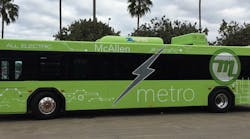AVTA's First Wireless Charging System Breaking Ground
Installation of a wireless charging station is underway at Lancaster City Park (LCP). The large-scale construction project will impact passengers who use the park’s busy transfer center to connect with public transit. AVTA intends to relocate several of its boarding locations as construction will make the bus bays inaccessible from Feb. 1 through Mar. 1, 2016. During construction, Routes 10, 94, 785, 786 and 787 will board passengers along the southern side of the park on Avenue K-8. Route 4 and the Lake L.A. Express will board passengers along the eastern side of the park on 10th Street West, and Routes 1, 5, 11 and 12 will board along the northern side of the platform which will not be obstructed by construction.
The in-ground inductive charging system was developed by Utah-based WAVE Inc. Once completed, AVTA will have the capacity to wirelessly charge the batteries of up to four electric buses each hour, enabling them to remain in service as long as their diesel counterparts. AVTA also intends to install a WAVE charging pad at the Palmdale Transportation Center (PTC) as part of its pilot program to demonstrate this new technology. Construction at PTC is expected to begin within the next two weeks.
"As a Board, we have a goal of 100% electrification of our bus fleet, and as we begin building the charging infrastructure, we are laying the foundation for a complete fleet conversion," said board chairman Marvin Crist. "Growth is an important factor, and this technology allows for future fleet expansion without range limitation. Wireless charging is the wave of the future and will enable electric buses to operate all day without having to take time to re-charge batteries back at the yard. "
Crews are now creating pathways for the primary and secondary wiring conduits to bring power from Edison to the equipment controlling the charging pad at the Lancaster transfer center. The charging pad will then be embedded at ground level, matching up with a receiver pad mounted underneath the bus. A bus simply needs to roll over the pad to enable the equipment to wirelessly couple and begin charging the bus’s batteries. The technology is safe because the electromagnetic waves have very little reach past the device underneath the bus.
"The wireless charging system is truly state-of-the-art technology, and our partnership with WAVE is a key component in our strategy to become the nation's first fully electric bus agency," stated executive director Len Engel. "It's exciting to see our vision for the future becoming a reality."
The project is being funded in part by grants from the Antelope Valley Air Quality Management District and the Supervisor Antonovich, County of Los Angeles.



